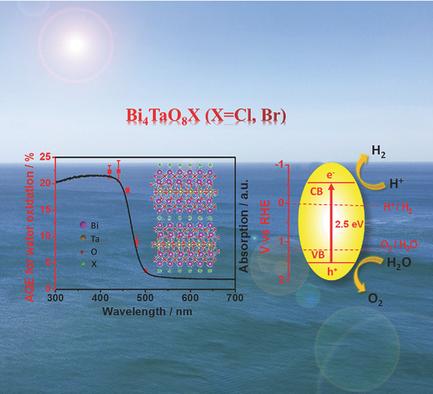当前位置:
X-MOL 学术
›
Adv. Energy Mater.
›
论文详情
Our official English website, www.x-mol.net, welcomes your
feedback! (Note: you will need to create a separate account there.)
Bismuth Tantalum Oxyhalogen: A Promising Candidate Photocatalyst for Solar Water Splitting
Advanced Energy Materials ( IF 24.4 ) Pub Date : 2017-09-01 , DOI: 10.1002/aenm.201701392 Xiaoping Tao 1, 2 , Yue Zhao 2, 3 , Linchao Mu 2, 3 , Shengyang Wang 2, 3 , Rengui Li 2 , Can Li 1, 2
Advanced Energy Materials ( IF 24.4 ) Pub Date : 2017-09-01 , DOI: 10.1002/aenm.201701392 Xiaoping Tao 1, 2 , Yue Zhao 2, 3 , Linchao Mu 2, 3 , Shengyang Wang 2, 3 , Rengui Li 2 , Can Li 1, 2
Affiliation

|
As wide range of light absorption and suitable redox potentials are prerequisites for photocatalytic water splitting, exploring new semiconductor‐based materials with proper band structures for water splitting still calls for longstanding efforts. In this work, a series of photocatalysts, bismuth tantalum oxyhalide, Bi4TaO8X (X = Cl, Br), with valence band and conduction band positions at ≈−0.70 and ≈1.80 eV versus the reversible hydrogen electrode (RHE), respectively, are found to be capable for both water oxidation and reduction under visible light irradiation. Using flux synthetic methods, Bi4TaO8X (X = Cl, Br) with microplatelet morphology can be successfully prepared. The photocatalyst based on these materials shows an apparent quantum efficiency as high as 20% at 420 nm for water oxidation. In addition, a Z‐scheme system coupling Bi4TaO8Br with Ru/SrTiO3:Rh is successfully achieved for overall water splitting with a stoichiometric ratio of H2 and O2 evolutions. This work demonstrates a new series of semiconductors Bi4TaO8X (X = Cl, Br) with the promising application in the field of solar energy utilization.
中文翻译:

铋钽氧卤:一种有前途的候选光催化剂,用于太阳能水的分解
由于广泛的光吸收和合适的氧化还原电势是光催化水分解的先决条件,因此探索具有合适的能带结构进行水分解的新型基于半导体的材料仍然需要长期的努力。在这项工作中,一系列光催化剂铋卤化铋钽Bi 4 TaO 8 X(X = Cl,Br),价带和导带的位置相对于可逆氢电极(RHE)分别为≈−0.70和≈1.80eV,发现分别在可见光照射下能够氧化和还原水。使用助熔剂合成方法,Bi 4 TaO 8可以成功制备具有微血小板形态的X(X = Cl,Br)。基于这些材料的光催化剂对水氧化显示出在420 nm处的表观量子效率高达20%。此外,成功实现了Bi 4 TaO 8 Br与Ru / SrTiO 3:Rh耦合的Z方案系统,以H 2和O 2逸出的化学计量比进行总的水分解。这项工作演示了一系列新的半导体Bi 4 TaO 8 X(X = Cl,Br),在太阳能利用领域具有广阔的应用前景。
更新日期:2017-09-01
中文翻译:

铋钽氧卤:一种有前途的候选光催化剂,用于太阳能水的分解
由于广泛的光吸收和合适的氧化还原电势是光催化水分解的先决条件,因此探索具有合适的能带结构进行水分解的新型基于半导体的材料仍然需要长期的努力。在这项工作中,一系列光催化剂铋卤化铋钽Bi 4 TaO 8 X(X = Cl,Br),价带和导带的位置相对于可逆氢电极(RHE)分别为≈−0.70和≈1.80eV,发现分别在可见光照射下能够氧化和还原水。使用助熔剂合成方法,Bi 4 TaO 8可以成功制备具有微血小板形态的X(X = Cl,Br)。基于这些材料的光催化剂对水氧化显示出在420 nm处的表观量子效率高达20%。此外,成功实现了Bi 4 TaO 8 Br与Ru / SrTiO 3:Rh耦合的Z方案系统,以H 2和O 2逸出的化学计量比进行总的水分解。这项工作演示了一系列新的半导体Bi 4 TaO 8 X(X = Cl,Br),在太阳能利用领域具有广阔的应用前景。











































 京公网安备 11010802027423号
京公网安备 11010802027423号